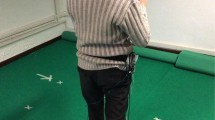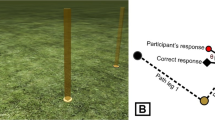Abstract
In this study, we investigated the role of interactive auditory feedback in modulating the inadvertent forward drift experienced while attempting to walk in place with closed eyes following a few minutes of treadmill walking. Simulations of footstep sounds upon surface materials such as concrete and snow were provided by means of a system composed of headphones and shoes augmented with sensors. In a control condition, participants could hear their actual footstep sounds. Results showed an overall enhancement of the forward drift after treadmill walking independent of the sound perceived, while the strength of the aftereffect, measured as the proportional increase (posttest/pretest) in forward drift, was higher under the influence of snow compared to both concrete and actual sound. In addition, a higher knee angle flexion was found during the snow sound condition both before and after treadmill walking. Behavioral results confirmed those of a perceptual questionnaire, which showed that the snow sound was effective in producing strong pseudo-haptic illusions. Our results provide evidence that the walking in place aftereffect results from a recalibration of haptic, visuo-motor but also sound-motor control systems. Self-motion perception is multimodal.




Similar content being viewed by others
References
Alton F, Baldey L, Caplan S, Morrissey MC (1998) A kinematic comparison of overground and treadmill walking. Clin Biomech 13(6):434–440
Anstis S (1995) Aftereffects from jogging. Exp Brain Res 103(3):476–478
Avanzini F, Rocchesso D (2001) Modeling collision sounds: non-linear contact force. In: Proceedings of the digital audio effects conference, pp 61–66
Baram Y, Lenger R (2012) Gait improvement in patients with cerebral palsy by visual and auditory feedback. Neuromodulation 15(1):48–52
Baram Y, Miller A (2007) Auditory feedback control for improvement of gait in patients with multiple sclerosis. J Neurol Sci 254(1):90–94
Brennan AA, Bakdash JZ, Proffitt DR (2012) Treadmill experience mediates the perceptual-motor aftereffect of treadmill walking. Exp Brain Res 216(4):527–534
Castiello U, Giordano BL, Begliomini C, Ansuini C, Grassi M (2010) When ears drive hands: the influence of contact sound on reaching to grasp. PLoS ONE 5(8):e12240
Cesari P, Camponogara I, Papetti S, Rocchesso D, Fontana F (2014) Might as well jump: sound affects muscle activation in skateboarding. PLoS ONE 9(3):e90156
Cook P (1997) Physically informed sonic modeling (PhISM): synthesis of percussive sounds. Comput Music J 21(3):38–49
Dingwell JB, Cusumano JP, Cavanagh PR, Sternad D (2001) Local dynamic stability versus kinematic variability of continuous overground and treadmill walking. J Biomech Eng 123(1):27–32
Durgin FH, Pelah A (1999) Visuomotor adaptation without vision? Exp Brain Res 127(1):12–18
Durgin FH, Pelah A, Fox LF, Lewis J, Kane R, Walley KA (2005) Self-motion perception during locomotor recalibration: more than meets the eye. J Exp Psychol Hum Percept Perform 31(3):398–419
Gaver W (1993a) How do we hear in the world? Explorations in ecological acoustics. Ecol Psychol 5(4):285–313
Gaver W (1993b) What in the world do we hear? An ecological approach to auditory event perception. Ecol Psychol 5(1):1–29
Hunt KH, Crossley FRE (1975) Coefficient of restitution interpreted as damping in vibroimpact. J Appl Mech 42(2):440–445
Lahav A, Saltzman E, Schlaug G (2007) Action representation of sound: audiomotor recognition network while listening to newly acquired actions. J Neurosci 27(2):308–314
Lécuyer A (2009) Simulating haptic feedback using vision: a survey of research and applications of pseudo-haptic feedback. Presence Tele Oper Virtual Environ 18(1):39–53
Lepers R, Brenière Y, Maton B (1999) Changes to the gait initiation programme following a running exercise in human subjects. Neurosci Lett 260(1):69–73
Li X, Logan RJ, Pastore RE (1991) Perception of acoustic source characteristics: walking sounds. J Acoust Soc Am 90(6):3036–3049
Molnar-Szakacs I, Overy K (2006) Music and mirror neurons: from motion to ‘e’motion. Soc Cogn Affect Neurosci 1(3):235–241
Nordahl R, Serafin S, Turchet L (2010) Sound synthesis and evaluation of interactive footsteps for virtual reality applications. In: Proceedings of the IEEE virtual reality conference, pp 147–153
O’Connor CM, Thorpe SK, O’Malley MJ, Vaughan CL (2007) Automatic detection of gait events using kinematic data. Gait Posture 25(3):469–474
Philbeck JW, Woods AJ, Arthur J, Todd J (2008) Progressive locomotor recalibration during blind walking. Percept Psychophys 70(8):1459–1470
Rieser JJ, Pick HL, Ashmead DH, Garing AE (1995) Calibration of human locomotion and models of perceptual-motor organization. J Exp Psychol Hum Percept Perform 21(3):480
Rodger MW, Young WR, Craig CM (2013) Synthesis of walking sounds for alleviating gait disturbances in Parkinson’s Disease. IEEE Trans Neural Syst Rehab Eng 22(3):543–548
Sedda A, Monaco S, Bottini G, Goodale MA (2011) Integration of visual and auditory information for hand actions: preliminary evidence for the contribution of natural sounds to grasping. Exp Brain Res 209(3):365–374
Seminati E, Nardello F, Zamparo P, Ardigò LP, Faccioli N, Minetti AE (2013) Anatomically asymmetrical runners move more asymmetrically at the same metabolic cost. PLoS ONE 8(9):e74134
Stolze H, Kuhtz-Buschbeck JP, Mondwurf C, Boczek-Funcke A, Jöhnk K, Deuschl G, Illert M (1997) Gait analysis during treadmill and overground locomotion in children and adults. Electroencephalogr Clin Neurophysiol 105(6):490–497
Thaut M, Abiru M (2010) Rhythmic auditory stimulation in rehabilitation of movement disorders: a review of current research. Music Percept 27(4):263–269
Turchet L, Serafin S (2013) Investigating the amplitude of interactive footstep sounds and soundscape reproduction. Appl Acoust 74(4):566–574
Turchet L, Serafin S, Dimitrov S, Nordahl R (2010a) Physically based sound synthesis and control of footsteps sounds. In: Proceedings of digital audio effects conference, pp 161–168
Turchet L, Nordahl R, Berrezag A, Dimitrov S, Hayward V, Serafin S (2010b) Audio–haptic physically based simulation of walking on different grounds. In: Proceedings of IEEE international workshop on multimedia signal processing. IEEE Press, pp 269–273
Turchet L, Serafin S, Cesari P (2013a) Walking pace affected by interactive sounds simulating stepping on different terrains. ACM Trans Appl Percet 10(4):1–14
Turchet L, Pugliese R, Takala T (2013b) Physically based sound synthesis and control of jumping sounds on an elastic trampoline. In: Proceedings of the 4th interactive sonification workshop, pp 87–94
Zanetti C, Schieppati M (2007) Quiet stance control is affected by prior treadmill but not overground locomotion. Eur J Appl Physiol 100(3):331–339
Acknowledgments
The research leading to these results has received funding from the Danish Council for Independent Research Technology and Production Sciences (FTP), Grant No. 12-131985.
Author information
Authors and Affiliations
Corresponding author
Appendix
Appendix
The developed footstep engine uses a sound synthesis technique known as physical modeling, where the physics of sound production mechanism is simulated.
Specifically, we adopted the impact model described in Avanzini and Rocchesso (2001) and a physically informed sonic model (PhiSM) (Cook 1997). These models were used to simulate walking on solid and aggregate surfaces, respectively. The two approaches are briefly recalled below.
The interaction between solid surfaces can be expressed by the force between two bodies (Hunt and Crossley 1975):
where x represents the contact interpenetration, k accounts for the material stiffness, λ represents the force dissipation due to internal friction during the impact, and α is a coefficient which depends on the local geometry around the contact surface. The model described has been discretized using the numerical method proposed in Avanzini and Rocchesso (2001).
In order to simulate particle interactions typical of aggregate surfaces, we adopted a PhiSM model. In this model, the interaction between the foot and the floor can be represented using a simple Poisson distribution, where the probability of sound production is constant at each time step, giving rise to an exponential probability weighting time between events.
In the experiment described in this paper, the footstep sounds synthesis is driven interactively by the user wearing the shoes. From the real acoustical signal of a footstep sound, the ground reaction force (GRF) is estimated, i.e., the reaction force supplied by the ground at every step. Such GRF is used to drive the described physical models, as explained in detail in Turchet et al. (2010a). A description of the control algorithms based on the analysis of the values of the pressure sensors embedded in the shoes can be found in Turchet et al. (2010b). The sound synthesis engine and the relative control algorithms were implemented using the Max/MSP sound synthesis and multimedia real-time platform.
Rights and permissions
About this article
Cite this article
Turchet, L., Camponogara, I. & Cesari, P. Interactive footstep sounds modulate the perceptual-motor aftereffect of treadmill walking. Exp Brain Res 233, 205–214 (2015). https://doi.org/10.1007/s00221-014-4104-9
Received:
Accepted:
Published:
Issue Date:
DOI: https://doi.org/10.1007/s00221-014-4104-9




